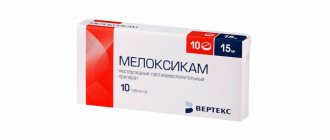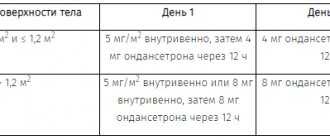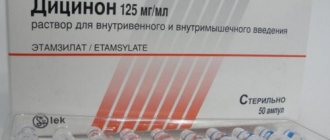Nosological classification (ICD-10)
- B02 Herpes zoster
- G50 Trigeminal nerve lesions
- G51 Lesions of the facial nerve
- G54.0 Lesions of the brachial plexus
- G54.9 Damage to nerve roots and plexuses, unspecified
- G58.0 Intercostal neuropathy
- G62.1 Alcoholic polyneuropathy
- G62.9 Polyneuropathy, unspecified
- G63.2 Diabetic polyneuropathy (E10-E14+ with common fourth character .4)
- G90.9 Autonomic nervous system disorder, unspecified
- H48.1 Retrobulbar neuritis in diseases classified elsewhere
- M54.1 Radiculopathy
- M54.4 Lumbago with sciatica
- M79.1 Myalgia
- M79.2 Neuralgia and neuritis, unspecified
- R25.2 Cramp and spasm
- R52 Pain not elsewhere classified
- R56.8 Other and unspecified convulsions
Compound
| Solution for intramuscular administration | 1 amp. (2 ml) |
| active ingredients: | |
| thiamine hydrochloride | 100 mg |
| pyridoxine hydrochloride | 100 mg |
| cyanocobalamin | 1 mg |
| lidocaine hydrochloride | 20 mg |
| excipients: benzyl alcohol - 40 mg; sodium polyphosphate or sodium tripolyphosphate - 20 mg; potassium hexacyanoferrate - 0.2 mg; sodium hydroxide solution 1 M - to pH 4–5; water for injection - up to 2 ml |
Pharmacodynamics
Neurotropic B vitamins have a beneficial effect on inflammatory and degenerative diseases of the nerves and musculoskeletal system. In high doses, they have analgesic properties, increase blood flow, normalize the functioning of the nervous system and the process of hematopoiesis.
Thiamine (B1) plays a key role in carbohydrate metabolism processes, which are crucial in the metabolic processes of nervous tissue, as well as in the Krebs cycle, with subsequent participation in the synthesis of TPP (thiamine pyrophosphate) and ATP. Pyridoxine (B6) is involved in the metabolism of proteins and partly in the metabolism of carbohydrates and fats. The physiological function of both vitamins (B1, B6) is to potentiate each other’s action, manifested in a positive effect on the nervous, neuromuscular and cardiovascular systems.
Cyanocobalamin (B12) is involved in the synthesis of the myelin sheath, stimulates hematopoiesis, reduces pain associated with damage to the peripheral nervous system, and stimulates nucleic acid metabolism through the activation of folic acid.
Lidocaine is a local anesthetic.
COMPLIGAM IN COMPLEX TAB No. 60
Clinical and pharmacological group
Vitamin B complex. Pharmacological action
A combination product containing B vitamins and lidocaine.
Neurotropic B vitamins have a beneficial effect on inflammatory and degenerative diseases of the nerves and musculoskeletal system. They are not used to eliminate deficiency conditions, but in large doses they have analgesic properties, increase blood flow, normalize the functioning of the nervous system and the process of hematopoiesis (vitamin B12).
Thiamine (vitamin B1) plays a key role in the processes of carbohydrate metabolism, which are crucial in the metabolic processes of nervous tissue, also in the Krebs cycle with subsequent participation in the synthesis of thiamine pyrophosphate and ATP. Pyridoxine (vitamin B6) is involved in the metabolism of proteins, and partly in the metabolism of carbohydrates and fats. The physiological function of both vitamins (B1 and B6) is to potentiate each other’s action, manifested in a positive effect on the nervous, neuromuscular and cardiovascular systems.
Cyanocobalamin (vitamin B12) is involved in the synthesis of the myelin sheath, stimulates hematopoiesis, reduces pain associated with damage to the peripheral nervous system, and stimulates nucleic acid metabolism through the activation of folic acid.
Lidocaine is a local anesthetic that causes all types of local anesthesia.
Pharmacokinetics
Suction and distribution
After intramuscular administration, thiamine is quickly absorbed from the injection site and enters the blood (484 ng/ml after 15 minutes on the first day of administration of a 50 mg dose) and is distributed unevenly in the body with its content in leukocytes of 15%, erythrocytes of 75% and in plasma blood 10%. Due to the lack of significant reserves of the vitamin in the body, it must be ingested every day. Thiamine penetrates the blood-brain barrier and the placental barrier and is excreted in breast milk.
After an intramuscular injection, pyridoxine is quickly absorbed into the bloodstream and distributed in the body, acting as a coenzyme after phosphorylation of the CH2OH group in the 5th position. About 80% of pyridoxine is bound to plasma proteins. Pyridoxine is distributed throughout the body, penetrates the placental barrier, and is excreted in breast milk.
Metabolism
The main metabolites are: thiaminecarboxylic acid, pyramine and some unknown metabolites. Of all the vitamins, thiamine is stored in the body in the smallest quantities. The adult human body contains within 30 mg of thiamine in the form of: 80% in the form of thiamine pyrophosphate, 10% thiamine triphosphate and the rest in the form of thiamine monophosphate.
Removal
Thiamine is excreted in the urine in the alpha phase after 0.15 hours, in the beta phase after 1 hour and in the terminal phase over 2 days.
Pyridoxine is deposited in the liver and oxidized to 4-pyridoxine acid, which is excreted in the urine, a maximum of 2-5 hours after absorption. The human body contains 40-150 mg of vitamin B6, its daily elimination rate is in the range of 1.7–3.6 mg with a replenishment rate of 2.2-2.4%.
Indications for use of the product CompligamV
For pathogenetic and symptomatic treatment of diseases and syndromes of the nervous system of various origins:
- neuropathy and polyneuropathy (diabetic, alcoholic and others);
- neuritis and polyneuritis, incl. retrobulbar neuritis;
- peripheral paresis, incl. facial nerve;
- neuralgia, incl. trigeminal nerve and intercostal nerves;
- pain syndrome (radicular, myalgia);
- night muscle cramps, especially in older age groups;
- plexopathies, ganglionitis (including herpes zoster);
- neurological manifestations of spinal osteochondrosis (radiculopathy, lumbar ischialgia, muscular-tonic syndromes).
Dosage regimen
In case of severe pain syndrome, it is advisable to begin treatment with intramuscular injection (deep) of 2 ml of the product every day for 5-10 days, with subsequent transition either to oral administration or to more rare injections - 2-3 times a week for 2 -3 weeks.
Side effect
Allergic reactions: skin reactions in the form of itching, urticaria; not often - hypersensitivity reactions to the product, incl. rash, difficulty breathing, angioedema, anaphylactic shock.
Other: in some cases - increased sweating, tachycardia, acne.
Contraindications to the use of the CompligamV product
- severe and acute forms of decompensated chronic heart failure;
- children's age (due to lack of research);
- high sensitivity to product components.
Pregnancy and lactation
It is not recommended to use the product during pregnancy and lactation (breastfeeding).
special instructions
In cases of very rapid administration of the product, systemic reactions may develop (dizziness, arrhythmia, convulsions).
Overdose
Symptoms: possible development of systemic reactions - dizziness, arrhythmia, convulsions.
Treatment: symptomatic therapy.
Drug interactions
Pyridoxine is not prescribed simultaneously with levodopa, since the effect is weakened later.
Taking into account the presence of lidocaine in the product, in the case of additional use of epinephrine and norepinephrine, increased side effects on the heart are possible. In case of overdose of local anesthetics, additional epinephrine and norepinephrine should not be used.
Pharmaceutical interactions
Thiamine completely decomposes in solutions containing sulfites.
Thiamine is unstable in alkaline and neutral solutions; administration with carbonates, citrates, barbiturates, and copper products is not recommended.
Vitamin B12 is incompatible with ascorbic acid and heavy metal salts.
Conditions for dispensing from pharmacies
The drug is available with a prescription.
Storage conditions and periods
List B. C The drug should be stored out of reach of children, protected from light at a temperature of 2° to 8°C. Shelf life: 2 years.
Pharmacokinetics
After intramuscular administration, thiamine is quickly absorbed from the injection site and enters the blood (484 ng/ml after 15 minutes on the first day of administration of a 50 mg dose) and is unevenly distributed in the body (in leukocytes 15%, erythrocytes 75% and blood plasma 10% ). Due to the lack of significant reserves of the vitamin in the body, it must be ingested daily. Thiamine penetrates the blood-brain barrier and the placental barrier and is found in breast milk. Thiamine is excreted in the urine in the alpha phase after 0.15 hours, in the beta phase after 1 hour and in the terminal phase within 2 days. The main metabolites are thiamine carboxylic acid, pyramine and some unknown metabolites. Of all the vitamins, thiamine is stored in the body in the smallest quantities. The adult human body contains about 30 mg of thiamine: 80% in the form of thiamine pyrophosphate, 10% thiamine triphosphate and the rest in the form of thiamine monophosphate. After intramuscular injection, pyridoxine is quickly absorbed into the bloodstream and distributed in the body, acting as a coenzyme after phosphorylation of the CH2OH group in the 5th position. About 80% of the vitamin binds to blood plasma proteins. Pyridoxine is distributed throughout the body, penetrates the placenta, and is found in breast milk. Deposited in the liver and oxidized to 4-pyridoxic acid, which is excreted in the urine, a maximum of 2–5 hours after absorption. The human body contains 40–150 mg of vitamin B6, its daily elimination is about 1.7–3.6 mg with a replacement rate of 2.2–2.4%.
COMPLIGAM B solution for intramuscular administration 2ml ampoule No. 5
Pharmaceutical group: Vitamin B complex. Pharmaceutical action: CompligamV is a combination drug containing B vitamins and lidocaine. Neurotropic B vitamins have a beneficial effect on inflammatory and degenerative diseases of the nerves and musculoskeletal system. They are not used to eliminate deficiency conditions, but in high doses they have analgesic properties, increase blood flow, normalize the functioning of the nervous system and the process of hematopoiesis (vitamin B12). Thiamine (B1) plays a key role in the processes of carbohydrate metabolism, which are crucial in the metabolic processes of nervous tissue, as well as in the Krebs cycle with subsequent participation in the synthesis of TPP (thiamine pyrophosphate) and ATP (adenosine triphosphate). Pyridoxine (B6) is involved in the metabolism of proteins, and partly in the metabolism of carbohydrates and fats. The physiological function of both vitamins (B1, B6) is to potentiate each other’s action, manifested in a positive effect on the nervous, neuromuscular and cardiovascular systems. Cyanocobalamin (B12) is involved in the synthesis of the myelin sheath, stimulates hematopoiesis, reduces pain associated with damage to the peripheral nervous system, and stimulates nucleic acid metabolism through the activation of folic acid. Lidocaine is a local anesthetic that causes all types of local anesthesia. Pharmacokinetics: After intramuscular administration of CompligamV, thiamine is quickly absorbed from the injection site and enters the blood (484 ng/ml after 15 minutes on the first day of administration of a 50 mg dose) and is distributed unevenly in the body with its content in leukocytes of 15%, erythrocytes of 75% and blood plasma 10%. Due to the lack of significant reserves of the vitamin in the body, it must be ingested daily. Thiamine penetrates the blood-brain and placental barriers and is found in breast milk. Thiamine is excreted in the urine in the alpha phase after 0.15 hours, in the beta phase after 1 hour and in the terminal phase within 2 days. The main metabolites are: thiaminecarboxylic acid, pyramine and some unknown metabolites. Of all the vitamins, thiamine is stored in the body in the smallest quantities. The adult human body contains about 30 mg of thiamine in the form of: 80% as thiamine pyrophosphate, 10% thiamine triphosphate and the rest as thiamine monophosphate. After intramuscular injection, pyridoxine is quickly absorbed into the bloodstream and distributed in the body, acting as a coenzyme after phosphorylation of the CH2OH group at the 5th position. About 80% of the vitamin binds to blood plasma proteins. Pyridoxine is distributed throughout the body, penetrates the placenta, and is found in breast milk. Deposited in the liver and oxidized to 4-pyridoxic acid, which is excreted in the urine, a maximum of 2-5 hours after absorption. The human body contains 40-150 mg of vitamin B6, its daily elimination rate is about 1.7 - 3.6 mg with a replacement rate of 2.2 - 2.4%.
Indications of the drug Compligam B®
As a pathogenetic and symptomatic remedy in the treatment of syndromes and diseases of the nervous system of various origins:
neuropathy and polyneuropathy, incl. diabetic, alcoholic;
neuritis and polyneuritis, incl. retrobulbar neuritis;
peripheral paresis, incl. facial nerve;
neuralgia, incl. trigeminal nerve and intercostal nerves;
pain syndrome (radicular, myalgia);
night muscle cramps, especially in older age groups;
plexopathies, ganglionitis (including herpes zoster);
neurological manifestations of spinal osteochondrosis (radiculopathy, lumbar ischialgia, muscular-tonic syndromes).
Compligam B 2 ml No. 5 solution for intramuscular injection
Instructions for medical use of the drug CompligamV® Trade name CompligamV® International nonproprietary name No Dosage form Solution for intramuscular administration, 2 ml Composition 2 ml of solution contain active substances: thiamine hydrochloride - 100 mg pyridoxine hydrochloride - 100 mg cyanocobalamin - 1.0 mg lidocaine hydrochloride – 20 mg, excipients: benzyl alcohol, sodium polyphosphate, potassium ferricyanide, sodium hydroxide 1 M solution, water for injection. Description Transparent liquid of pinkish-red color with a characteristic specific odor. Pharmacotherapeutic group Vitamins. B complex of vitamins in combination with other drugs. ATC code A11EX Pharmacological properties Pharmacokinetics of Thiamine hydrochloride After intramuscular administration, thiamine is quickly absorbed from the injection site and enters the blood (484 ng/ml after 15 minutes on the first day of administration of a 50 mg dose) and is distributed unevenly in the body with its content in leukocytes of 15%, erythrocytes 75% and in blood plasma 10%. Thiamine penetrates the blood-brain and placental barriers and is found in breast milk. Vitamin B1 (thiamine) is dephosphorylated in kidney tissue. Thiamine is excreted in the urine in the alpha phase after 0.15 hours, in the beta phase after 1 hour and in the terminal phase within 2 days. The main metabolites are: thiaminecarboxylic acid, pyramine. Of all the vitamins, thiamine is stored in the body in the smallest quantities. Pyridoxine hydrochloride After intramuscular injection, pyridoxine (vitamin B1) is quickly absorbed into the bloodstream and distributed in the body, acting as a coenzyme after phosphorylation of the CH2OH group in the 5th position. About 80% of the vitamin binds to blood plasma proteins. Pyridoxine is distributed throughout the body, penetrates the placenta, and is found in breast milk. Deposited in the liver and oxidized to 4-pyridoxic acid, which is excreted in the urine, a maximum of 2-5 hours after absorption. Cyanocobalamin Cyanocobalamin (vitamin B12), when released into the blood plasma, binds to proteins to form a transport complex. In this form, it is absorbed by the liver tissue. Cyanocobalamin also accumulates in the bone marrow and passes through the hematoplacental barrier. Cyanocobalamin is excreted mainly in bile, in an amount of 0.5-5 mcg per day, while about 70% is reabsorbed and enters the enterohepatic circulation. Cyanocobalamin has a relatively long half-life (T1/2) of 123 hours. Pharmacodynamics CompligamV® has a beneficial effect on inflammatory and degenerative diseases of the nerves and musculoskeletal system. When used in high doses, it has analgesic properties, increases blood flow, normalizes the functioning of the nervous system and the process of hematopoiesis (vitamin B12). Thiamine is metabolized in the body into cocarboxylase (thiamine diphosphate) and thiamine triphosphate by phosphorylation. Cocarboxylase, as an enzyme coenzyme, is involved in the carbohydrate metabolism chain, which is important for the normal functioning of nerves and nervous tissue. Improves conductivity in nerves by influencing synaptic transmission. Vitamin B1 deficiency is accompanied by the accumulation in tissues of under-oxidized products of carbohydrate metabolism: pyruvic acid, lactic acid. As a result, the functioning of the nervous tissue is disrupted with the formation of various pathological conditions. Pyridoxine is phosphorylated in body tissues. Metabolic products are coenzymes of non-oxidative metabolism of almost all amino acids. Coenzymes are involved in the decarboxylation of amino acids with the formation of many physiologically active mediators - adrenaline, tyramine, dopamine, histamine, serotonin. Also involved in the anabolism and catabolism of amino acids through transamination processes. Vitamin B6 affects the metabolism of tryptophan; under its influence, α-amino-β-ketoadininic acid is catalyzed in the process of hemoglobin formation. Cyanocobalamin is involved in the synthesis of the myelin sheath, stimulates hematopoiesis, reduces pain associated with damage to the peripheral nervous system, and stimulates nucleic acid metabolism through the activation of folic acid. Lidocaine is a local anesthetic that causes all types of local anesthesia. Indications for use As a pathogenetic and symptomatic agent in the treatment of diseases and syndromes of the nervous system of various origins: neuropathy and polyneuropathy (diabetic, alcoholic and others) neuritis and polyneuritis, including retrobulbar neuritis, peripheral paresis, including the facial nerve neuralgia, including the trigeminal nerve and intercostal nerves pain syndrome (radicular, myalgia) nocturnal muscle cramps, especially in older age groups plexopathy, ganglionitis (including herpes zoster) neurological manifestations of spinal osteochondrosis (radiculopathy, lumboischialgia, musculotonic syndromes ) Method of administration and dosage In case of severe pain syndrome, it is advisable to begin treatment with intramuscular injection (deep) of 2 ml of the drug daily for 5-10 days, with subsequent transition either to oral administration or to more rare injections (2-3 times a week in within 2-3 weeks). Maximum single dose – 2.0 ml, Maximum daily dose – 2.0 ml, Frequency of administration – once a day. The duration and frequency of treatment courses is determined by the doctor. Side effects dizziness, arrhythmias, convulsions (with rapid administration of the drug) tachycardia acne, itching, urticaria skin rash, swelling of the mucous membrane of the upper respiratory tract, Quincke's edema, anaphylactic shock increased sweating Contraindications individual sensitivity to any of the components of the drug decompensated heart failure, severe cardiac conduction disorders in children and adolescents up to 18 years of age, pregnancy and lactation Drug interactions Vitamin B1 Thiamine is completely destroyed in solutions containing sulfites. Other vitamins are inactivated in the presence of vitamin B1 breakdown products. Thiamine is incompatible with oxidizing substances, mercuric chloride, iodide, carbonate, acetate, tannic acid, ferric ammonium citrate, as well as phenobarbital, riboflavin, benzylpenicillin, dextrose and metabisulfite. Copper accelerates the breakdown of thiamine; in addition, thiamine loses its effect with increasing pH values (more than pH 3). Vitamin B6 Pyridoxine is not prescribed simultaneously with levodopa, since the effect of the latter is weakened. Vitamin B6 may also interact with cycloserine, D-penicillamine, epinephrine, norepinephrine, and sulfonamides, which reduces the effect of pyridoxine. Vitamin B12 Cyanocobalamin may increase allergic reactions caused by thiamine. Cyanocobalamin is incompatible with ascorbic acid and heavy metal salts. Taking into account the presence of lidocaine in the composition of the drug, in the case of additional use of adrenaline and norepinephrine, increased side effects on the heart are possible. In case of overdose of local anesthetics, additional adrenaline and norepinephrine should not be used. Special instructions When the drug is administered very quickly, dizziness, arrhythmia, and convulsions may occur (these symptoms may also be the result of an overdose of the drug). Features of the drug's influence on the ability to drive vehicles and potentially dangerous mechanisms Considering the side effects of the drug, care should be taken when driving and working with potentially dangerous mechanisms. Overdose Symptoms – increased side effects of the drug. Treatment is symptomatic. There is no specific antidote. Release form and packaging Solution for intramuscular administration. 2 ml in light-protective glass ampoules with a colored break ring or with a colored dot and notch. The ampoules are additionally coated with one, two or three colored rings and/or a two-dimensional bar code, and/or an alphanumeric coding, or without additional color rings, a two-dimensional bar code, or an alphanumeric coding. 5 ampoules each in a blister pack made of polyvinyl chloride film and aluminum foil or polymer film or without foil and without film. 1 or 2 blister packs along with instructions for medical use in the state and Russian languages in a cardboard pack. Storage conditions Store in a place protected from light at a temperature of 2 to 8 ºС. Storage and transportation at temperatures below 2 °C are not allowed. Keep out of the reach of children! Shelf life: 2 years Do not use after the expiration date indicated on the package. Conditions for dispensing from pharmacies By prescription Manufacturer Closed joint-stock company “Pharm”, Russia 141345, Moscow region, Sergiev Posad municipal district, rural settlement Bereznyakovskoye, pos. Belikovo, 11 Tel./fax. Owner of the registration certificate Closed Joint Stock Company "Pharm", Russia Address of the organization that accepts claims from consumers on the quality of products (products) in the Republic of Kazakhstan IP "Tipkey" 050004, RK, Almaty, Abylay Khan Avenue 60, office 720. Tel.: +7 705 286 18 0
Interaction
Thiamine completely decomposes in solutions containing sulfites.
Thiamine is unstable in alkaline and neutral solutions; administration with carbonates, citrates, barbiturates, and copper preparations is not recommended.
Pyridoxine is not prescribed simultaneously with levodopa, since the effect of the latter is weakened.
Taking into account the presence of lidocaine in the composition of the drug, in the case of additional use of adrenoline and norepinephrine, increased side effects on the heart are possible. In case of overdose of local anesthetics, additional adrenoline and norepinephrine should not be used.
Vitamin B12 is incompatible with ascorbic acid and heavy metal salts.




